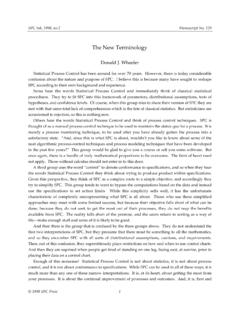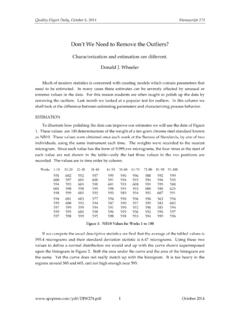Transcription of A Study of Statistical Process Control - SPC Press
1 A Study of Statistical Process Control Henry R. Neave How effectively is SPC being taught and used? We believe that the following report about British companies would find an echo in the The UK Economic and Social Research Council supported an investigation of the use and training of SPC, conducted by Peter Cheng with the assistance of Samuel Dawson. (Dr. Cheng is a research fellow in the ESRC Center for Research in Development, Instruction, and Training at the University of Nottingham.) In the Study , semi-structured interviews were conducted with managers and engineers who were responsible for SPC.
2 Ten manufacturing companies, producing a wide variety of products and ranging in size from 10 to 400+ employees, participated. The main findings were: The machine operators in companies using SPC most effectively had generally benefited from better levels of education or training (or both). In those companies, there was less involvement of engineering and managerial levels in the day-to-day use of SPC. Operators not only recorded and plotted data on Control charts, but also interpreted the charts and often attempted the diagnosis and solution of problems. A variety of approaches to training was found, from traditional classroom courses to interactive computer and video systems.
3 The effectiveness of both older and newer modes of teaching appeared limited. The difference in most of the successful SPC companies was that the training was generally augmented with supervised hands-on work on the shop floor. There were major education and training needs at all levels in most of the companies, from chart completion skills for operators, right through to basic conceptual knowledge about SPC at managerial levels. Henry Neave read and commented on a draft of this report, and in a number of conversations with Dr. Cheng, interpreted the findings in a wider context than was possible in the Study itself.
4 The essence of Dr. Neave's comments is reproduced in the dialogue which follows. Cheng: Thank you for reading the paper. Neave: As I suspect will be no surprise to you, I found the findings of your report to be profoundly disturbing. Cheng: Yes, we were continually surprised by how ineffectively the companies were using SPC. and the inappropriateness of their forms of training. Neave: But I think your report reveals many deeper problems that would be interesting to 1. A Study of Statistical Process Control Henry R. Neave consider. Even your introduction, in which you state Statistical Process Control (SPC) is one of the basic tools of TQM, indicates one root of the problem.
5 If indeed SPC is regarded as a mere tool of TQM, the reasons for most of the difficulties reported by you become immediately self- evident. For, as Don Wheeler pointedly concludes in his video, A Japanese Control Chart, SPC. is not a tool or technique. SPC is a whole new way of thinking. If that way of thinking is absent, most of the power of SPC is automatically lost, or at least hidden. It is, therefore, hardly surprising that you found many people, at all levels in the various organizations you examined, who were not exactly turned on by the topic! (That happens when the blind lead the blind, which I fear is an apt description of much of the training mentioned in your report.)
6 Cheng: That SPC is more than a tool is something many of the engineers and managers did seem to appreciate, although we found that they were, in reality, just using it as a tool. Neave: There are plenty of other clues in your report as to the sources of difficulties. For example, SPC is not a relatively complex and difficult tool to learn and to use although I agree that most teachers and consultants manage to make it appear so! Furthermore, variation is not a hard concept to understand.. Cheng: Learning and using SPC was not such a problem in the better companies, but it certainly was for many employees in the other companies, who had low levels of education (even lacking basic numeracy).
7 Some employees even found it difficult to fill in a Control chart, let alone relate particular patterns in those charts to problems in a Process . A lack of basic education was one of the fundamental problems we identified. Neave: You are right to say that a knowledge of statistics is not essential in order for operators to use SPC. Truth is, a knowledge of statistics (assuming you mean the usual stuff taught in most educational institutions throughout the country) is a positive hindrance at any level. Walter Shewhart himself (the creator of SPC and the Control chart in the 1920s) expressly indeed passionately denied the need for such knowledge of statistics.
8 And this denial became even more explicit when expressed by Shewhart's most famous prot g , Dr. W. Edwards Deming. In Out of the Crisis, page 335, he writes: It is true that some books on the Statistical Control of quality and many training manuals for teaching Control charts show a graph of the normal curve and proportions of area thereunder. Such tables and charts are misleading and derail effective Study and use of Control charts.. Another clue to the origin of the problems related in your report is the repeated use of the word training in respect to learning about SPC.
9 I interpret the word training in terms of the acquisition of specific skills: how to do things, but not why. Thinking, learning, interpreting, understanding, developing knowledge: these are what SPC is really about. And these are not training. These are education. People often trot out the phrase training and education as if the two were one and the same. They are not. There again we have a cause of the difficulties you have found. Cheng: Most interesting. The most common perception we found was that SPC is a training matter. Although to be fair, much of the material that we examined did attempt to give some explanation 2.
10 A Study of Statistical Process Control Henry R. Neave of why SPC is essential, albeit peripherally. Neave: Incidentally, this also explains why you discovered many people who thought that SPC. training needed to be industry-specific, or even job-specific. When there is no understanding, the best anyone can do is to copy. But if instead they are helped to understand SPC, there may be virtue in not being job- or industry-specific. A deep understanding of SPC brings about an appreciation of its generic and universal nature. Cheng: Ideally, we would hope that learners would understand that concept.





